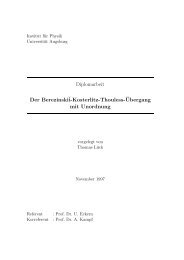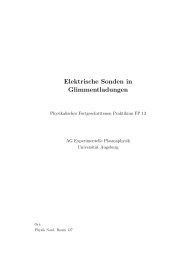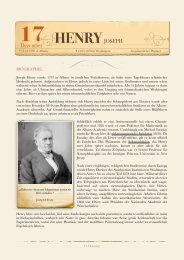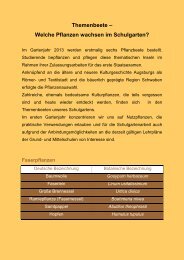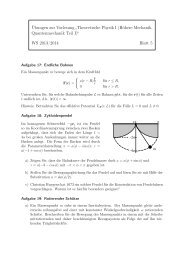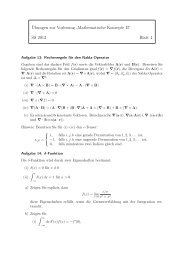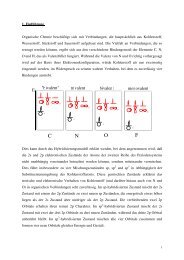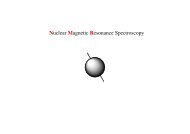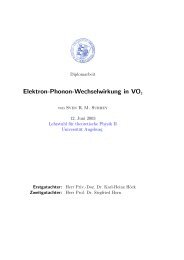Numerical Renormalization Group Calculations for Impurity ...
Numerical Renormalization Group Calculations for Impurity ...
Numerical Renormalization Group Calculations for Impurity ...
You also want an ePaper? Increase the reach of your titles
YUMPU automatically turns print PDFs into web optimized ePapers that Google loves.
3.2. Summary of the Basic Techniques 21<br />
NRG deals with those many electronic degrees of freedom in a certain sequence<br />
(iteratively). How do we distribute the huge number of electrons into a<br />
sequence of diagonalization steps? How can one describe the correlations among<br />
the electrons in different steps? Section 3.2.2 is devoted to answer the questions.<br />
3.2.2 Iterative diagonalization of a semi-infinite chain<br />
Let us start from the Hamiltonian with p = 0 Fourier components only.<br />
∑<br />
H = ε f f † −1σ f −1σ + Uf † −1↑ f −1↑f † −1↓ f −1↓ + ∑ ∑<br />
ξ n a † nσ a nσ<br />
σ<br />
σ n<br />
+ √ ∑<br />
η 0 (f −1σf † 0σ + f 0σf † −1σ ), (3.26)<br />
with<br />
σ<br />
f 0σ =<br />
η 0<br />
= ∑ n<br />
1 ∑<br />
√ ¯h n a nσ ,<br />
η0<br />
n<br />
¯h 2 n. (3.27)<br />
Now we drop the index p (= 0) from the conduction operators (a (†)<br />
0σ,n → a nσ).<br />
(†)<br />
The well-known Lanczos algorithm <strong>for</strong> converting matrices to a tridiagonal <strong>for</strong>m<br />
maps the Hamiltonian in Eq. (3.26) into a semi-infinite chain.<br />
∑<br />
H = ε f f −1σf † −1σ + Uf † −1↑ f −1↑f † −1↓ f −1↓ + √ ∑<br />
η 0 (f −1σf † 0σ + f 0σf † −1σ )<br />
+ ∑ σ<br />
σ<br />
∑<br />
n<br />
[<br />
]<br />
ε n f nσ † f nσ + t n (f nσ † f n+1σ + f † n+1σ f nσ)<br />
σ<br />
(3.28)<br />
where operators f nσ (†) (n = 1, 2, ...) are represented as a linear combination of<br />
conduction operators a (†)<br />
mσ by a real orthogonal trans<strong>for</strong>mation U (U T U = UU T =<br />
1, U ∗ = U):<br />
f nσ = ∑ U nm a mσ . (3.29)<br />
m<br />
The parameters of the semi-infinite chain are calculated recursively with the<br />
relations (Bulla, Lee, Tong and Vojta 2005),<br />
ε m<br />
= ∑ n<br />
ξ n U 2 mn ,<br />
t 2 m<br />
= ∑ n<br />
[(ξ n − ε m )U mn − t m−1 U m−1n ] 2 , (3.30)<br />
U m+1n = 1<br />
t m<br />
[(ξ n − ε m )U mn − t m−1 U m−1n ] ,



